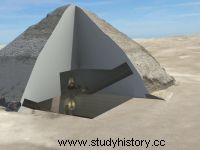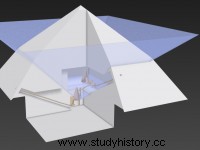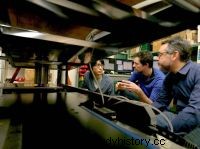Science and the Future was in Cairo to attend the press conference of the Scan Pyramids team, at the Grand Egyptian Museum in Giza. Report.
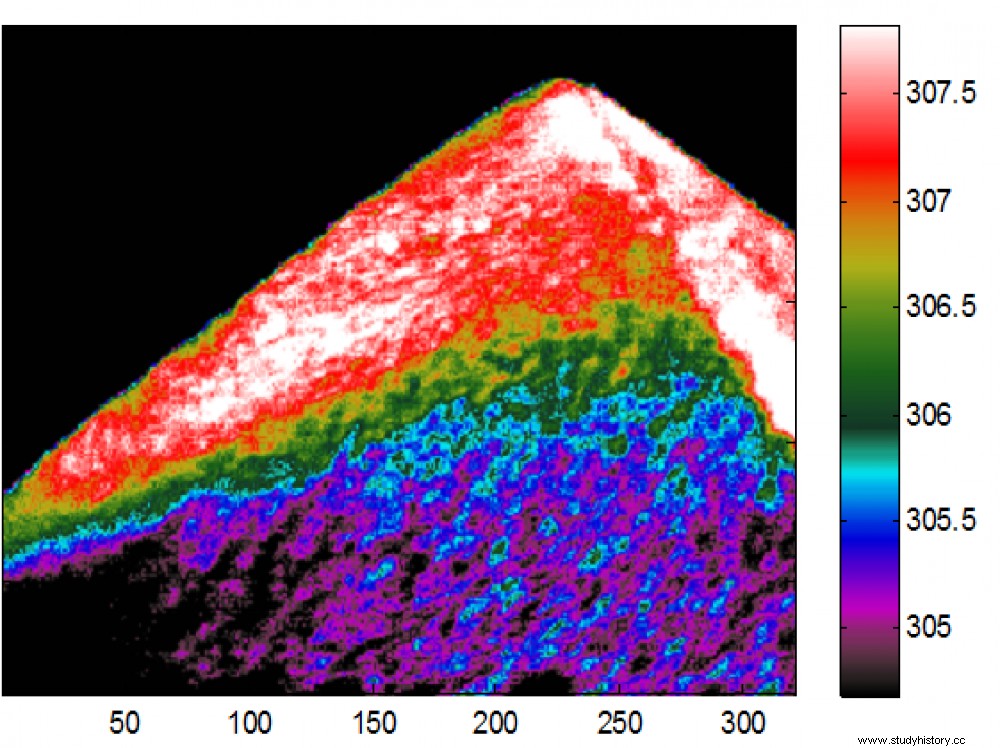
This infrared thermography image shows a marked temperature difference between the hot top of Dahshur's red pyramid (in red) and the colder bottom (blue and purple) of about 3 degrees. A very frank separation that is not found on the other sides.
Dressed in his white lab coat, Professor Morishima adjusts the microscope, under the lenses of photographers and cameramen. The device is connected to a computer. On the large screen, behind the conference table, appears an image showing dots and paths. Enigmatic...and spectacular! Because these cabalistic signs are muons captured by the films placed the team from the University of Nagoya (Japan) in the rhomboidal pyramid of Dahshur. A scientific first. "The smallest particles in the world to see the heart of the greatest monuments! “, enthuses Mehdi Tayoubi, of the French Institute HIP (Heritage Innovation Preservation).
This is one of the good news announced by the Scan Pyramids team during the press conference held this Sunday, January 17, 2016 in the morning, at the Grand Egyptian Museum in Giza. It was a question of taking stock of this international mission launched in October 2014 by HIP and the Faculty of Engineers of Cairo, with the aim of using innovative non-destructive technologies to probe the massif of the great funerary monuments of the 4th Dynasty.
We will have to interpret the images from the "muon campaign"
First success therefore:the "muon campaign" of the Japanese team. A week ago, scientists removed from the lower chamber of the rhomboidal pyramid the sensors they had placed there to trap these cosmic particles which permanently bombard the Earth, and like X-rays, make it possible to X-ray the buildings in depth. With the hope of revealing structures hitherto invisible. About sixty films have already been developed, hundreds of thousands of particles have been shown in them. It now remains to interpret the images, as is done for medical X-rays. When all are developed, the films will be sent to Japan for analysis. Results during March (below, the photosensitive surfaces used with the muon technology in the heart of the pyramids).
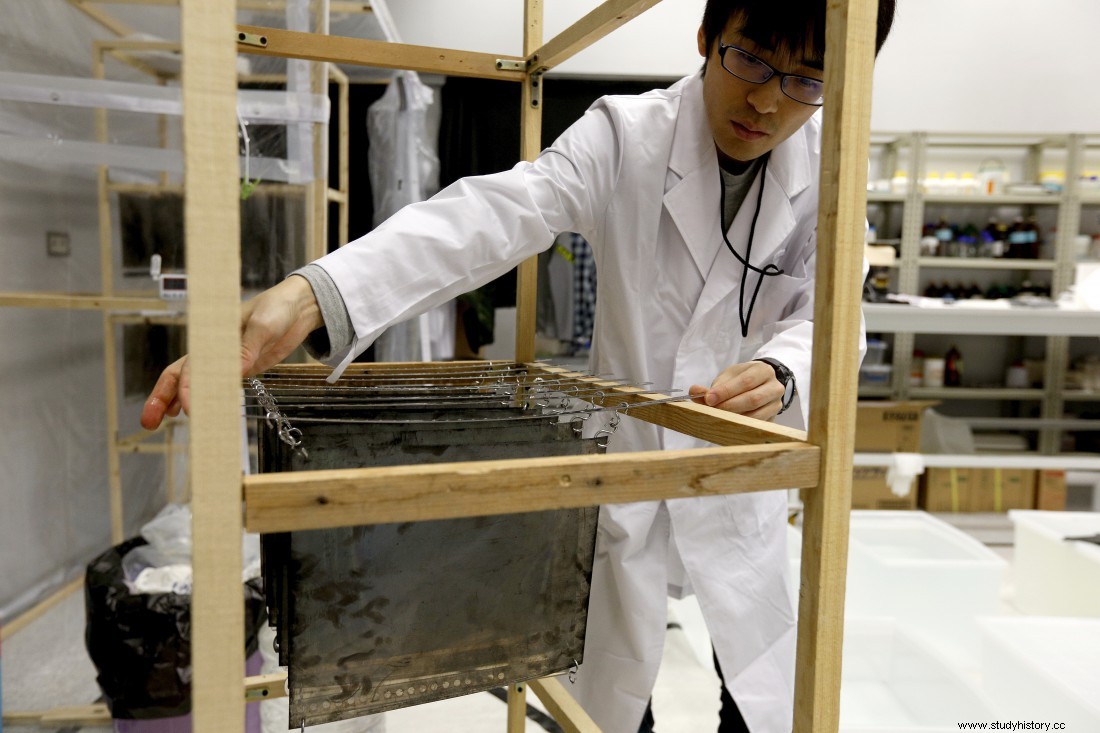 INFRARED. "The sensors placed in the rhomboid covered a field of 90° degrees. If a structural anomaly is hidden in the massif of the monument, the images will reveal it to us" , rejoices Mehdi Tayoubi. Like all great pyramids, the building indeed has its share of mysteries, with a plan of great complexity that many archaeologists and architects assume is not fully known. Other results announced on January 17, those of the first infrared campaign, said to be of short duration. On November 9, 2015, a disturbing anomaly was revealed on the east face of Kheops with, during the warming phase of the pyramid, a temperature difference of up to 6 degrees between two neighboring blocks. Other points of interest have been detected. On the north face of Cheops, an image very similar to that of the east face, with almost the same assembly of stones. Also on Kheops, a hotter temperature spot above the right chevron of the grand entrance, but not above the left chevron. Finally, Dahshur's red pyramid delivered a very strange result. "The West Face , says Dr. Hany Helal, co-director of the mission for Cairo University, shows a clear separation between a cold zone and a hot zone, which is not found on the other sides." On either side of an oblique line that starts from the bottom of the monument, the temperature difference is several degrees, day and night, between the top, which is warmer, and the base, which is colder. "It could be an effect of the wind, explains Matthieu Klein, specialist in infrared thermography at Laval University (Quebec),but if it were only that the delimitation would not be so clear." (Below are the chemical baths used to reveal the muon images).
INFRARED. "The sensors placed in the rhomboid covered a field of 90° degrees. If a structural anomaly is hidden in the massif of the monument, the images will reveal it to us" , rejoices Mehdi Tayoubi. Like all great pyramids, the building indeed has its share of mysteries, with a plan of great complexity that many archaeologists and architects assume is not fully known. Other results announced on January 17, those of the first infrared campaign, said to be of short duration. On November 9, 2015, a disturbing anomaly was revealed on the east face of Kheops with, during the warming phase of the pyramid, a temperature difference of up to 6 degrees between two neighboring blocks. Other points of interest have been detected. On the north face of Cheops, an image very similar to that of the east face, with almost the same assembly of stones. Also on Kheops, a hotter temperature spot above the right chevron of the grand entrance, but not above the left chevron. Finally, Dahshur's red pyramid delivered a very strange result. "The West Face , says Dr. Hany Helal, co-director of the mission for Cairo University, shows a clear separation between a cold zone and a hot zone, which is not found on the other sides." On either side of an oblique line that starts from the bottom of the monument, the temperature difference is several degrees, day and night, between the top, which is warmer, and the base, which is colder. "It could be an effect of the wind, explains Matthieu Klein, specialist in infrared thermography at Laval University (Quebec),but if it were only that the delimitation would not be so clear." (Below are the chemical baths used to reveal the muon images).
DURATION. "It is much too early to draw conclusions from these first measurements, insists Dr. Hany Helal. They are too punctual. It is more meaningful to see the temperature change over time." This is why the Université de Laval team, guided by the data from the short mission, is now preparing a campaign lasting 24 hours to a few days on each side of each of the pyramids, a prelude to the long infrared mission, which will observe the effects of seasonal changes. "What interests us is what is structural, deep, that varies slowly, explains Matthieu Klein.All volatile images reflect changes that take place on the surface and can be induced by weather phenomena" . Simulations, precise images of the blocks and their arrangement obtained thanks to the future 3D photography campaign by drones, positioning outside the pyramids of another type of muon sensor, less precise, but capable of reconstructing images in time real… The next phases of the mission will enable the data to be cross-checked and validated. "This is a long mission, concludes Mehdi Tayoubi, which must be constantly adapted according to the results obtained. These monuments are more than four thousand years old. We can't expect to solve their mysteries in a few weeks!"

